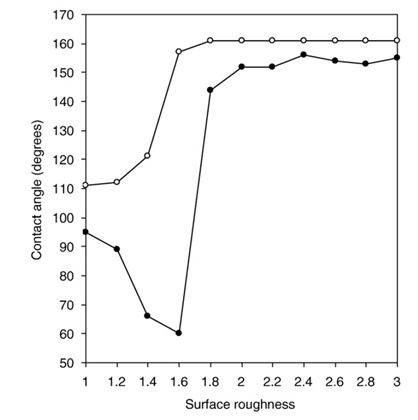|
Particle
surface roughness is the other ones affecting variables
on flotation
Wenzel suggested that the geometry of the surface had a
greater effect on the static contact angle than did the
chemistry!..
The
wettability of real surfaces is subject to many factors,
both physical and chemical. For the flotation process,
the effect of four main factors; surface roughness,
heterogeneity, particle shape, and particle size, on
contact angle measurements are of importance
(Chau et al., 2009).
T.T. Chau, W.J. Bruckard, P.T.L. Koh,
A.V. Nguyen, A review of factors that affect contact
angle and implications for flotation practice, Advances
in Colloid and Interface Science 150 (2009) 106–115.

Figure:
Static contact angle ( advancing angle and the receding)
of water on wax substrates, as a function of the
substrate roughness (Johnson,
Dettre, 1964).
For hydrophobic surfaces the data of
Johnson, Dettre,
(1964),
reported in the Figure
above,
show the effects of advancing θa (maximum static angle)
and receding θr (minimumstatic angle) contact angles of
water on surfaces of wax of variable roughness.
As the roughness increases, small variations in the
angles, together with significant increases in
hysteresis, are observed. Then, both angles suddenly
increase as the hysteresis diminished. It was concluded
that texturing a solid does not only modify the
hysteresis but it can also affect dramatically the value
of the mean contact angle itself.
Johnson RE, Dettre RH. Adv Chem Ser
1964;43:112–35.
Wotruba et al. [1991]
reported contradiction results from flotation tests
carried out on zircon samples before and after
attritioning for 48h in a planetary mill. It was noted
that the particle shape remained unchanged by the
attritioning and only the particle surfaces were
roughened. It was shown that the freshly roughened
material floated in total far better than the original
material.
Wotruba H, Hoberg H, Schneider FU.
XVIIth Int Miner ProcessCong IV 1991:83–95.
Successful particle–bubble
attachment involves three steps, viz., 1) thinning of
the intervening liquid film to a (critical) thickness
where the film ruptures, 2) rupture of the intervening
liquid film and formation of a three-phase contact (tpc)
nucleus (a hole of a critical wetting radius) and 3)
expansion of tpc line from the critical radius to form a
stable wetting perimeter
(Chau et al., 2009).
T.T. Chau, W.J. Bruckard, P.T.L. Koh,
A.V. Nguyen, A review of factors that affect contact
angle and implications for flotation practice, Advances
in Colloid and Interface Science 150 (2009) 106–115.
|